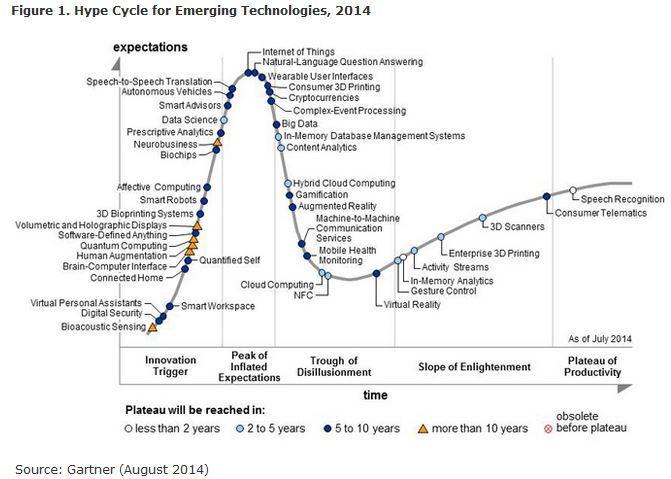A certain commercial advisory club still releases its hype cycle. Which is good news; to have some authority with some authority (your mileage may vary) providing us with some comprehension and comprehensiveness [OK I’ll stop now] about the What’s Buzzworthy.
Still, being … in the field / Dutch / obnoxious, pick any; I’d like to comment…:
(Here’s the August version from … somewhere; ™ and © or what is it, acknowledged)

- Virtual Personal Assistants – 5 to 10 years out (of the plateau of productivity) ..? That’s optimistic ..!
- Brain-computer interface: If one would consider this to be about ‘intelligence’ connection, then maybe. But there’s also connections like hearing, et al., where a 5 to 10 year span may be on the ‘long’ side.
- Human augmentation: See the previous. Or aren’t definitions sufficiently orthogonal?
- Affective computing: Hm, optimists.
- Neurobusiness: Same.
- IoT: Yes, at a hype peak. Maybe (much) sooner, to be at the plateau.
- Cryptocurrencies: Hoping for a swifter spread and adoption…
- Big Data may be further down the slope already. Or is that from where I / we are ..?
- Gamification, augmented reality: Hopefully and quite possibly, already reality somewhat earlier.
- The rest of the bunch … will they not come sooner ..? Of shift shape (‘pivot’) to be unrecognizable from their today’s hype labels soon?
- And a final one: Would anyone have a similar overview of … one year, five and ten years back? Just to see what happen in the meantime; to establish a ballpark reliability figure. Would be fun, too.
I’ll leave you with this’all. Your comments are welcome(d). If you like to dream.













